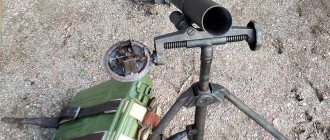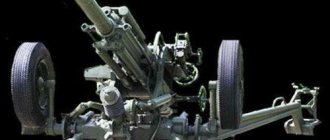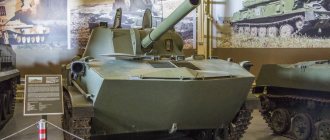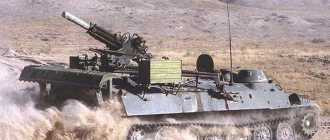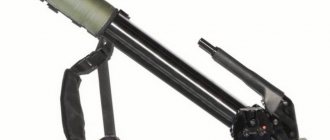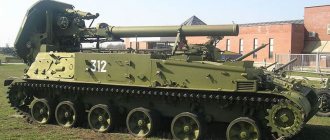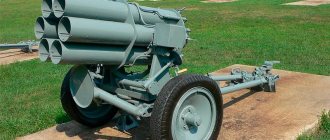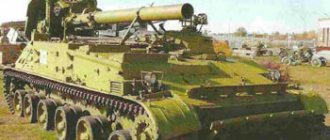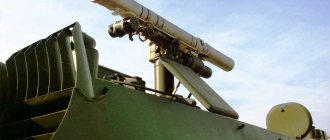This term has other meanings, see Sleigh (meanings).
| 2S12 "Sleigh" | |
| 120-mm mortar complex 2S12 “Sani”, consisting of a 2B11 mortar and a 2F510 transport vehicle | |
| Type | mortar complex |
| A country | USSR |
| Service history | |
| Years of use | 1981 - present vr. |
| Adopted | 1981 |
| Wars and conflicts | Afghan war, First Chechen war, Second Chechen war, Armed conflict in eastern Ukraine, Civil war in Syria |
| Production history | |
| Designed by | 1979 |
| Manufacturer | Uraltransmash (Ekaterinburg) Motovilikha plants (Perm) |
| Total issued | ~1500 |
| Characteristics | |
| Weight, kg | 210 |
| Crew (crew), people. | 5 |
| Projectile | 120 mm artillery mine |
| Carriage | wheel travel 2L81 |
| Elevation angle | +45°…+80° |
| Angle of rotation | ±4° |
| Rate of fire, rounds/min | to 10 |
| Initial projectile speed, m/s | 325 |
| Maximum range, m | 7100 |
| Aim | MPM-44M |
| Media files on Wikimedia Commons | |
2S12 "Sleigh"
- Soviet towed mortar system of 120 mm caliber, providing transportation of the mortar in both transportable and towed ways.
To this day, it is in service with the Armed Forces of the Russian Federation, as well as the armed forces of most CIS countries and a number of countries around the world. Developed in 1979 by designers of the Burevestnik Central Research Institute. In 1981, the complex was adopted by the Soviet Army [1] Armed Forces of the USSR.
TTX[edit | edit code]
120-mm mortar system 2S12 “Sani”[edit | edit code]
- 2B11 mortar weight (combat position): 210 kg;
- wheel weight: 115 kg;
- weight of the mortar system with the 2F510A transport vehicle (on the Ural-43206-0651 chassis with ammunition): 11,020 kg;
- maximum initial mine speed: 325 m/s;
- targeted rate of fire: up to 10 rounds/min.;
- maximum firing range: 7100 m;
- minimum firing range: 480 m;
- time to transfer the mortar from the traveling position to the combat position and back: no more than 3 minutes;
- transportable ammunition: 56 rounds;
- speed when towing a mortar on wheels: off-road, on dirt and cobblestone roads for short distances (5...10 km): no more than 20 km/h;
- on an asphalt or concrete highway, if necessary, for short distances (30 km): no more than 60 km/h.
120-mm mortar 2B11[edit | edit code]
Main article: 120 mm transportable mortar 2B11
The 120 mm 2B11 mortar consists of:
- trunk,
- double charging fuse,
- two-legged carriage,
- base plate,
- sight MPM-44M.
The barrel is designed to fire a shot and impart an initial speed to the mine in a certain direction. Barrel composition:
- pipe,
- breech
- obturating ring.
Types of mortars
The most popular in the military industry was the 120 mm mortar of the 1943 model called PM-43, on the basis of which a large number of modern modifications were developed:
- 2B11 - standard version;
- 2B24 - a domestic modification that is significantly superior in fire performance to all imported analogues; 2B11 - a modification produced under license in Bulgaria;
- 2S12 - is a mortar complex called “Sani”. Its design is represented by the 2F510 vehicle (GAZ-66 vehicle), on which the installation is transported, and the 2L81 wheel drive, intended for use with the standard version of the 2B11 mortar;
- 2K32 - 2B24 class mortar is located on an armored tracked base;
- 2B25 - used by special units. It has a number of advantages that allow it to carry out attacks in which the enemy cannot determine the location of the installation and, as a result, eliminate it. It is also available in the “Commandos” version with a firing range of up to 3 km and a total weight of the structure not exceeding 12 kg.
Options and modifications[edit | edit code]
The crew rolls the mortar along the gangway into the body of a 2F510A transport vehicle using an electric winch.
- 2S12
- towed version with a 2F510 transport vehicle on a GAZ-66-05 chassis (wheel arrangement 4 × 4, a set of special equipment 2F32 - a winch equipped with an electric drive, a gangway for rolling a mortar on wheels into the body using a winch, fastening elements for the mortar in the body , etc.)[1]; - 2S12A
- a modernized towed version with a 2F510A transport vehicle on the Ural-43206 chassis (Ural-43206-0551-41 or Ural-43206-0651: 4 × 4 wheel arrangement, a set of special equipment 2F32 - electric winch, gangway, fastening elements, etc. )[1][2]; - 2S12B or “Dilemma-2S12”
is a self-propelled version based on the MT-LB armored personnel carrier[1]. - 2B11A
- a new base plate with a hinge, can be aimed horizontally without turning the support, a Ural transport vehicle with a high-power diesel engine, and an electric winch for loading a mortar.[3]
After the 2022 modernization, mobility and firing accuracy increased (it received the KM-8 “Gran” guided weapon system - high-explosive fragmentation mines with a 9E430 laser-type homing head; this allows you to hit stationary and moving targets at a distance of 9000 meters at any time of the day and without zeroing).[4]
Prospects for 2B11
Currently, developers are busy creating a new look for a unified set of 120 mm 2B11 mortars in order to provide the design with maximum firing range with full automation of preparation and firing of high-precision ammunition.
The configuration of the mortar will directly depend on its load capacity and dimensions. At the same time, a simplified system created on a hydropneumatic support is planned to be placed on a Tiger and IVECO class chassis, which will have a significant impact not only on transportation, but also on ease of use. It is planned to improve the existing version so much that the fire attack will be carried out without noise, flame and smoke accompanying the shot.
The continuous development of new models and improvement of existing mortar installations ensures the support of Russia's consistently high rating in the field of military industry and provides the state with one of the first places on the world stage.
Notes[edit | edit code]
- ↑ 1 2 3 4 5 Yuri Avdeev.
All-weather “Sleigh” // Red Star: gas. - 2015. - No. 19 (February 6). — P. 17. - Modernized 120-mm mortar system 2S12A on the chassis of the Ural-43206 vehicle (unspecified)
.
Military products
. Official website of JSC Central Research Institute Burevestnik. Date accessed: July 28, 2022. - The modernized mortars entered service with the artillery formation of the Southern Military District in Adygea (unspecified)
. armstrade.org. Date accessed: May 25, 2022. - ↑ 12
Second wind: modernization has expanded the capabilities of the Sani mortar // RG, 04/27/2021
Performance characteristics of 2K32 Deva
— Chassis type: MT-LB (MT-LBM1) - Years of operation: since 2011
— Crew: 6 people
Weight 2K32 Virgo
— Combat weight, t: 11.3
Overall dimensions 2K32 Deva
- Body length, mm: 6500 - Width, mm: 2865 - Height, mm: 1950 - Base, mm: 3700 - Track, mm: 2500 - Ground clearance, mm: 395..415
Reservation 2K32 Virgo
— Armor type: bulletproof
Armament 2K32 Virgo
- Caliber and brand of gun: 82-mm 2B24 - Gun type: smoothbore mortar - Gun ammunition: 84 - VN angles, degrees: +45..+85 - GN angles, degrees: 360 - Machine guns: 1 x 7.62 -mm PKT or 1 x 12.7 mm KORD
Firing range 2K32 Virgo
- 3VO36 round with 3-O-26 fragmentation mine: 6000 m - 3VO1 round with O-832 DU fragmentation mine: 3922 m - 3VO18 round with 3-O-12 fragmentation mine: 3922 m - 3VO12 round with 3-O fragmentation mine -12: 3107 m
Engine 2K32 Deva
— Engine type: YaMZ-238V
Speed 2K32 Virgo
— Highway speed, km/h: 60 - Cross-country speed, km/h: 35 (6 afloat)
— Suspension type: independent torsion bar; Fording, m: floating
Mortar 120 mm performance characteristics
The 2B11 mortar can fire all kinds of mines with a caliber of 120 mm. Even guided mines of the KM-8 “Gran” category belong to this category; by this fact alone one can properly judge the combat characteristics that the 120 mm mortar shows. Feedback from military personnel about this weapon also allows us to judge the maximum firing range, which is about 7500 m when loaded with conventional weapons.
The total weight for all modifications, including the 2B11 itself, is 210 kg, allowing for more than 15 rounds per minute with an initial charge speed of at least 325 m/s. The design of the barrel with a length of 1740 mm provides a vertical guidance angle ranging from +45° to +80°. Horizontal indicators fluctuate within ±5°, maintaining sighting indicators of 360° with a horizontal firing angle from 5° to 26°.
Operators
- Belarus Belarus - 61 2С12 “Sani”, as of 2016
- Bosnia and Herzegovina Bosnia and Herzegovina - 23 2B11 (used under the designation UK-2), as of 2012
- Venezuela Venezuela - 48 2С12 “Sani”, as of 2016
- Georgia Georgia - 14 2С12 “Sleigh”, as of 2016
- Kazakhstan Kazakhstan - 45 2B11 and M-120, as of 2016
- Kyrgyzstan Kyrgyzstan - 6 2С12 “Sani”, as of 2016
- Libya Libya - a number of 2B11, as of 2016
- Lithuania Lithuania - 5 2B11, as of 2016
- Russia Russia: Russian Ground Forces - 1700 2S12 "Sani", (of which 1000 are in storage), as of 2016
- Russian Border Troops - 90 units 2S1, 2S9 and 2S12 “Sani”, as of 2016
- Ukrainian Ground Forces - 190 2S12 “Sani”, as of 2016
Combat use
- Second Chechen war.
- Armed conflict in eastern Ukraine - used by both sides of the conflict. [ not in source
]
Basic data
The 120 mm mortar, whose destruction radius when firing guided mines reaches 9000 m, is by far the most effective weapon for suppressing enemy firepower and covering the movement of infantry units.
Firing is carried out using mortar rounds with GVMZ-7 class fuses and a variable charge. It is noteworthy that the 2F510 vehicle (GAZ-66 car) with a V-shaped 8-cylinder engine, in which the 2B11 is transported, can transport with it only a strictly defined supply of charges, placed in 24 boxes. The ammunition is designed to fire 48 shots, which can be fired by a 120 mm mortar. The characteristics of the device allow loading and unloading 2B11 into the body of a car without the use of heavy equipment.
If for some reason there are not enough people to carry out this procedure, the mortar is transported in tow. At the same time, the 2F510 engine is gasoline and belongs to the ZMZ-66-06 class, the power of which reaches 120 hp. With. In this case, the maximum permissible speed on the highway is 90 km/h.
If a vehicle with a mortar launcher must ford a river, preliminary measurements will have to be taken for the vehicle to pass normally. In the deepest place, the maximum permissible water level should not exceed 1 m.
The brake system is equipped with a hydraulic drive with several circuits and hydraulic vacuum boosters on each of them. These factors make it possible to ensure reliable transportation of the 2B11 even in difficult combat conditions. The only weakness of the 2F510 is the dependent suspension on polyelliptic springs with shock absorbers.


